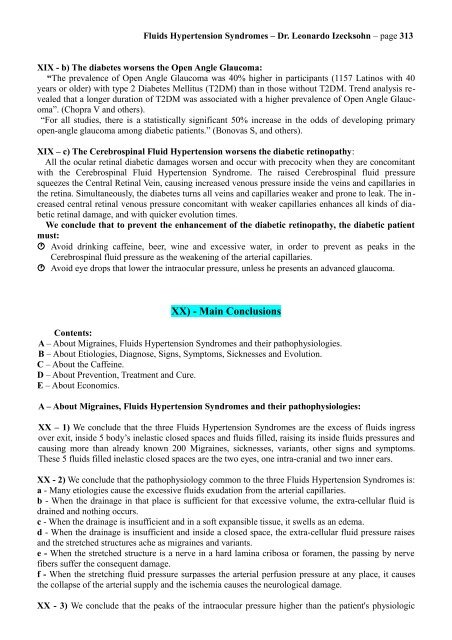Fluids Hypertension Syndromes: Migraines, Headaches, Normal ...
Fluids Hypertension Syndromes: Migraines, Headaches, Normal ...
Fluids Hypertension Syndromes: Migraines, Headaches, Normal ...
You also want an ePaper? Increase the reach of your titles
YUMPU automatically turns print PDFs into web optimized ePapers that Google loves.
<strong>Fluids</strong> <strong>Hypertension</strong> <strong>Syndromes</strong> – Dr. Leonardo Izecksohn – page 313<br />
XIX - b) The diabetes worsens the Open Angle Glaucoma:<br />
“The prevalence of Open Angle Glaucoma was 40% higher in participants (1157 Latinos with 40<br />
years or older) with type 2 Diabetes Mellitus (T2DM) than in those without T2DM. Trend analysis revealed<br />
that a longer duration of T2DM was associated with a higher prevalence of Open Angle Glaucoma”.<br />
(Chopra V and others).<br />
“For all studies, there is a statistically significant 50% increase in the odds of developing primary<br />
open-angle glaucoma among diabetic patients.” (Bonovas S, and others).<br />
XIX – c) The Cerebrospinal Fluid <strong>Hypertension</strong> worsens the diabetic retinopathy:<br />
All the ocular retinal diabetic damages worsen and occur with precocity when they are concomitant<br />
with the Cerebrospinal Fluid <strong>Hypertension</strong> Syndrome. The raised Cerebrospinal fluid pressure<br />
squeezes the Central Retinal Vein, causing increased venous pressure inside the veins and capillaries in<br />
the retina. Simultaneously, the diabetes turns all veins and capillaries weaker and prone to leak. The increased<br />
central retinal venous pressure concomitant with weaker capillaries enhances all kinds of diabetic<br />
retinal damage, and with quicker evolution times.<br />
We conclude that to prevent the enhancement of the diabetic retinopathy, the diabetic patient<br />
must:<br />
Avoid drinking caffeine, beer, wine and excessive water, in order to prevent as peaks in the<br />
Cerebrospinal fluid pressure as the weakening of the arterial capillaries.<br />
Avoid eye drops that lower the intraocular pressure, unless he presents an advanced glaucoma.<br />
XX) - Main Conclusions<br />
Contents:<br />
A – About <strong>Migraines</strong>, <strong>Fluids</strong> <strong>Hypertension</strong> <strong>Syndromes</strong> and their pathophysiologies.<br />
B – About Etiologies, Diagnose, Signs, Symptoms, Sicknesses and Evolution.<br />
C – About the Caffeine.<br />
D – About Prevention, Treatment and Cure.<br />
E – About Economics.<br />
A – About <strong>Migraines</strong>, <strong>Fluids</strong> <strong>Hypertension</strong> <strong>Syndromes</strong> and their pathophysiologies:<br />
XX – 1) We conclude that the three <strong>Fluids</strong> <strong>Hypertension</strong> <strong>Syndromes</strong> are the excess of fluids ingress<br />
over exit, inside 5 body’s inelastic closed spaces and fluids filled, raising its inside fluids pressures and<br />
causing more than already known 200 <strong>Migraines</strong>, sicknesses, variants, other signs and symptoms.<br />
These 5 fluids filled inelastic closed spaces are the two eyes, one intra-cranial and two inner ears.<br />
XX - 2) We conclude that the pathophysiology common to the three <strong>Fluids</strong> <strong>Hypertension</strong> <strong>Syndromes</strong> is:<br />
a - Many etiologies cause the excessive fluids exudation from the arterial capillaries.<br />
b - When the drainage in that place is sufficient for that excessive volume, the extra-cellular fluid is<br />
drained and nothing occurs.<br />
c - When the drainage is insufficient and in a soft expansible tissue, it swells as an edema.<br />
d - When the drainage is insufficient and inside a closed space, the extra-cellular fluid pressure raises<br />
and the stretched structures ache as migraines and variants.<br />
e - When the stretched structure is a nerve in a hard lamina cribosa or foramen, the passing by nerve<br />
fibers suffer the consequent damage.<br />
f - When the stretching fluid pressure surpasses the arterial perfusion pressure at any place, it causes<br />
the collapse of the arterial supply and the ischemia causes the neurological damage.<br />
XX - 3) We conclude that the peaks of the intraocular pressure higher than the patient's physiologic


